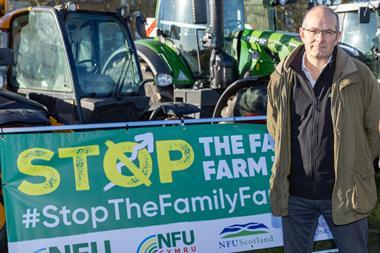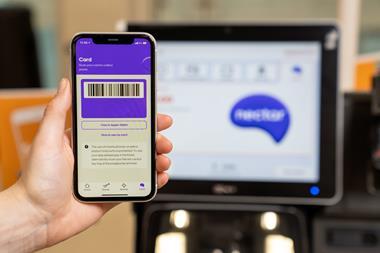Sainsbury’s chief executive Justin King explains why he’s still looking up. By Julia Taylor and Adam Leyland
Picture the scene: Britain’s GDP is suffering its sharpest drop in 10 years. Retail sales are nosediving. Inflation is in double figures. And interest rates are at 15%. Sound familiar? This was the recession of 1990–1992. So where was Sainsbury’s chief executive Justin King?
“Häagen–Dazs. I was launching the world’s most expensive ice cream.” And how did it go? “Fabulously,” he beams.
King is aware of the irony. Once again, despite very tough trading conditions, Sainsbury’s is doing perhaps not fabulously, but remarkably well. With sales up 7.6% to £10.7bn, with like-for-like growth of 3.9% and profits up 13.3% to £272m, he refuses to be downhearted.
Sainsbury’s is on track for 4% gross space growth this year, rising to 5% in 2009/2010. And there are plans to triple the speed of c-store expansion, with 150 new stores planned by 2011. That it coincides with a trend for local shopping is just luck, King says.
“Convenience is very much in tune with customers wanting to buy fresh food locally. There are some long-term reasons for doing it, and that’s why we’re doing it now.”
Confessing himself a natural-born optimist, King has repeatedly, counterintuitively talked up Sainsbury’s performance in the downturn and believes the British have “this unique ability to talk ourselves into a hole”.
“There’s a climate of fear about the credit crunch that’s out of step with the current reality,” he argues, “much of which has nothing to do with consumers.” So how can King be so optimistic, with unemployment rising sharply and the economy in apparent recession?
“You see,” he says, “you’re guilty of it too. I don’t want to be flippant, or downplay at all people losing their jobs, but unemployment only started rising in the UK four months ago. You wouldn’t believe that if you looked at the year-long downbeat reporting.”
“House repossessions are rising,” King adds, “but are still a long way from historical recessionary peaks.”
Even a 30% fall in house prices would leave only 15% of the population in negative equity, and that itself, he argues, is “a theoretical concept” for most people. King is also buoyed by interest rates, petrol prices and food prices coming down.
“Yes, the pig has gone through the python, but it’s misleading to say all costs are up. Your mortgage is costing less today than it was a year ago, and petrol prices are back where they were two years ago.”
He also argues that customers have been able to “dial out of inflation” by switching and saving. Seeing customers change – buying more promotions and own label– prompted Sainsbury’s to launch Switch and Save, one of three initiatives launched by the supermarket to “engage in a positive way” with the downturn.
King dismisses suggestions he is unfairly attacking branded manufacturers. He heralds Switch and Save as “free and fair” competition, and claims to have run Sainsbury’s biggest ever brand promotion at the same time as its launch.
“What’s wrong with a bit of competition? I always find it strange that people say they are free marketeers, but when they get a bit of competition they get sniffy about it. We’re providing customers with a choice and sometimes a better choice. Our tomato sauce, which is a better product than the leading brands, has more tomatoes, less salt, less sugar, than the leading brand.”
Another initiative, Cook and Save, better known as Feed Your Family for a Fiver, is in fact a relaunch of the Try Tip cards launched by Sainsbury’s as part of the Jamie Oliver Try Something New Today campaign three years ago. In encouraging people to re-engage with cooking, they’ve been very popular, says King, but repitching the cards from a budgeting point of view has been even more successful.
“The step change in the uptake of the cards and the uptake of the ingredients on the cards has been fantastic,” King says. Along with Shop and Save, these initiatives prove Sainsbury’s is far more responsive to shopper needs.
“When I joined in 2004, Sainsbury’s was very cost and operationally driven. It was focusing on IT, supply chain. Those were real problems, but it was almost as if [it was saying] we’ll have to take a raincheck on customers.”
Sainsbury’s is also better positioned than rivals such as Waitrose and M&S because although it shares a lot of the same values and has a reputation as a premium- end supermarket, it offers choice.
New custom is coming Sainsbury’s way, King believes, from the more up-market M&S or Waitrose shopper.
“We deliver value for money, but we have universal appeal. If you want to change what you buy, you couldn’t do that in Waitrose for example. If customers want to shop grams per penny, they can with Basics. If they want to switch from brands to own label, they can. If they want to switch between brands they can. If they want to buy ingredients they can. And to a greater or lesser extent, the two mentioned don’t provide that choice.”
Is Sainsbury’s in danger of jettisoning its brand values? Not a bit, says King. “Our Basics range has all of Sainsbury’s brand standards. Our Basics fish fingers use sustainable palm oil – the first product in any supermarket to do so – and sustainable pollock. We’re saying to customers, if you want to save pennies you can do so without compromising on standards. As Joanne [Denney-Finch] said at the IGD conference: ‘Consumers want value for their values.’ That describes exactly what we’re doing.”
At the moment King has no plans to follow Tesco down the route of discount tertiary brands. But he is open minded. “We don’t feel the need to add another layer to our offer - brands that our customers probably won’t recognise and don’t know what they are,” he says. “But as with all of these things you have to watch them closely. No retailer had Basics and value lines 15 years ago, and we all have them now –who’s to say that the same won’t happen?”
King adds that Sainsbury’s does not need to respond to the discounters, but does not go so far as to say that Tesco’s response has been an overreaction.
“We don’t think about the challenge. We look at our customers, what they are demanding from us, and what our customers tell us is that those who are shopping for grams-per-penny, that our basics range is better than what they see in discounters. It’s better and it’s cheaper. If you take the top 100–selling lines in grocery and price match Sainsbury’s value with any discounter range you’ll find that we are cheaper and better quality.”
“Generally it’s more affluent customers who buy promotions. And Basics is not just bought by customers with a tight budget. Six out of 10 of our customers buy Basics at one time or another.”
Basics is growing faster than any other line in store, but Taste the Difference sales are also up, King adds, though he admits by not as much. The other success story has been fair trade, which King says is still continuing to grow.
“Inevitably in tougher times less people will make the choice to move into it [fair trade], but I don’t think people will switch out. And that’s exactly what we’re seeing.”
But he concedes that the sales success of fair trade may be down to a widening of the range.
“We are still in the middle of switching our coffee and tea, there’s quite a lot of supply chain–driven growth in fair–trade, as more products come into store, and therefore there’s greater availability.”
High–husbandry meat also remains popular, which he puts down to this year’s television campaigns by Jamie Oliver and other celebrity chefs, but organic is on the wane.
“High–animal–husbandry meat, we can still see very strong growth in, particularly, chicken. Whereas organic is flat, I believe. It might even be down a bit.”
Perhaps the most counterintuitive aspect of King’s optimism is his attitude towards non–food. The Tu range, now in more than 240 Sainsbury’s, is growing three times as fast as food, with King claiming it to be the “ninth-biggest brand by volume in the UK from a standing start in three years”.
Name: Justin King
Job: CEO, Sainsbury's
Age: 47
Status: Married, two children
Education: Tudor Grange School, Solihull; BA, business administration, Bath University
Career: Started as a graduate trainee at Mars, and was briefly a production shift manager on the Galaxy line. Switched to PepsiCo in the Middle East in 1989. Moved to Grand Metropolitan and Häagen-Dazs. Joined Asda in 1994 and became managing director of the hypermarkets division. Moved to Marks & Spencer in 2001 to manage the food division, and was widely credited for the launch of Simply Foods. Joined Sainsbury's as CEO in 2004.
Non-execs: Staples, the US-based office products company.
Hobbies: Sailing, supporting Manchester United, gardening.
What happened to the Maserati? He sold it. King now drives a Lexus hybrid.
Surprising fact: He grows his own fruit and vegetables.
“Clearly, in market terms, our non food market shares are tiny,” he admits. “We might be the ninth biggest by volume but we only have about 1.5% market share by value. So we’re trying to go from 1% to 2% to 3%. Whether that market is a 90, 100 or 110 probably doesn’t matter overly much because we’re small in the scheme of the total share of market.”
So while King is “delighted” with non–food progress, he believes there is a lot of potential. “This is about us growing up and seeing how big we can go with our shops,” he says. “Most of our non-food growth is within our own gift. It’s what you might call opportunity growth, presenting customers with the opportunity for the first time to buy non–food in Sainsbury’s. Would it be easier to grow the non-food business in a different consumer climate? Of course it would. But I don’t think there’s anything in the market that makes it impossible to deliver the growth ambitions.”
Those growth ambitions require a lot of planning. When King first started Sainsbury’s had a trading format of up to 50,000 sq ft.
“Above that, we didn’t have a trading model that would fill the space,” King says. “Even two years ago we were typically extending stores about 70,000 sq ft at most. “The Sydenham store is 95,000 sq ft, with over 30,000 sq ft of non–food, and I think we have seven stores with that level of footprint in. Remember, of course, that clothing and non food has a very long timeline so, one of the things you have to do when you build a non food business, which I think we’ve done very successfully, is to project the footage you’re going to add at least 12–18 months out. Our buyers today are buying for square footage we expect to have next year, and that hasn’t even been built yet.
“It’s an incredibly rapid pace of development from where we’ve come from, over a two-three–year period.”
With the store expansions pipeline back on track after a hiatus – having been put on hold by King as he was forced to go back to basics – Sainsbury’s is no longer at a disadvantage versus its Big Four rivals. So is he expecting to pick up any bargains?
“I think the reality is that the market for supermarket space is incredibly competitive, and therefore the pricing for that space remains robust.”
Richard Jones is currently in gardening leave and is due to join Tesco in the new year. But King insists non-food is well-set, with Claire Sollis is heading up clothing and Adrian Mountford in home.
“One of [Richard’s] strengths was that he recruited and built a great team,” King says. “And I think if you look at our current training, the team continues to do a fantastic job.”
King doesn’t kid himself about how tough it is, however, and believes it requires “relentless communication”, something he admits was lost at the time of the abortive Delta 2 and CVC takeover talks (or what he calls the ‘non-bids’), because it “inevitably consumes a bit of a chief executive’s time”.
His staff have been an important facet of King’s time at Sainsbury’s, which is why he was “quite pleased”, when in January this year he stepped into the shoes of departing retail director Ken McMeikan. This he says, was both constructive and instructive for him.
“I’ve worked very hard to stay in touch with colleagues and customers,” he says. “It’s a big part of what I think a chief executive in a retail business has to do. It forced me to get closer than I would otherwise have been. I spent a lot more time in shops than I had in a while.”
King also has nothing but praise for Roger Burnley, who eventually took on the role of retail and logistics director in April.
“When I announced who our retail director was going to be, we happened to have a conference of all the retail management team. Roger got a standing ovation. One of Roger’s particular skills is that he’s a great leader of people. He empowers people to be their best. And that’s what he’s done. He’s created an environment where the retail team feel, justifiably, the focus of the business. He’s very challenging and expects high levels of performance, but he has a coaching approach to underperformance.
“So if Roger catches you doing something wrong, the focus is on helping you do it right the next time and not giving you a bollocking about not doing it right the last time.”
In terms of day-to-day planning, Kings says he looks at performance store-by-store, carrying out stunt deals on product lines to see who performs best.
“The point being we celebrate the success of those who have done well, but we’re not shy of identifying those who haven’t done well, and showing them what’s possible. Actually you don’t need to pick up the phone to point it out to them. If you publish a league table it’s amazing the impact that has.”
Communication with staff will be more important as confidence is shaken by wave–after–wave of bad news. So far it’s paying off.
“You saw a lot of reporting through August and September about M&S and Waitrose slowing down, and suggesting Sainsbury’s would be next. We were confidently communicating to our people that we didn’t see that being the case because of the improvements we’d made.
“So when we came out with our trading statement it proved the point, and our colleagues were absolutely delighted. They know they’re doing a great job for customers and they can feel it.”
















No comments yet